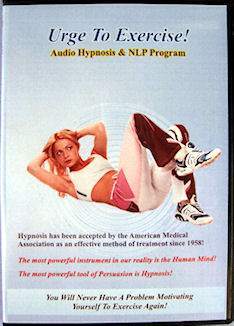
|
|
Hypnosis For Exercise MotivationYour Secret Weapon
Click here to email this
page to a friend. |
||
|
If
you're like many people, you are interested in developing an
exercise plan that will help you stay in shape and lose
weight. But you
may be surprised to find out that not any old type of
exercise will do - in fact, studies consistently show that
there are two basic types of exercise that are both highly
efficient and successful. Because
so many people have trouble with exercise
motivation, performing the most efficient types of
exercise is imperative, since the less time you spend
exercising - and the less time you waste on inefficient
exercise - the more likely you will be to continue to
exercise and therefore to reach your personal weight and
strength goals. The
first type of exercise that has been consistently shown to
help people lose weight and get in shape is progressive
resistance. In brief, progressive resistance is a particular type of
strength training. It
works by progressively ramping up the amount of weight
lifted, the number of sets, and number of reps performed.
The result is that muscle fibers are never strained
or damaged - instead, they slowly and steadily strengthen
without any setbacks. The
second type of exercise that has been thoroughly studied is
cardiovascular training.
This name is given to any type of exercise that gets
the heart rate up to 60 - 85 percent of its maximum.
Examples of cardio training could include jogging,
jump rope, aerobics, or treadmill, among others, but the
choice is up to you. Although
progressive resistance and cardio training alone have been
found to be highly efficient forms of exercise, it turns out
that combining them is the best bet for success.
By performing both progressive resistance and cardio
training, you will strengthen muscle groups and build
whole-body endurance. In
a recent study, exercisers who participated in both cardio
and progressive resistance over a two-month period lost 45
percent more weight than those doing cardio or progressive
resistance alone. Just
as important as the type of exercise you perform is the way
in which you exercise.
It probably will come as no surprise that consistency
is the name of the game. Exercising irregularly may strain your muscles and will
probably not help build strength and endurance.
Nor will it improve your overall health. According to many experts, the best plan is to exercise for
40 minutes to an hour 3 - 5 times per week.
Unfortunately,
for a significant subset of the population, getting enough
exercise is not just as easy as going to the gym several
times every week or listening to what the experts say.
For these people, exercise motivation is the primary
problem - they simply don't want to go to the gym.
In fact, they may dread any and all exercise, to the
point of severe anxiety.
It
is not known what percentage of the American population
suffers from problems with motivation
to exercise, but experts say that up to 20 to 40 percent
of people claim that they "hate" or
"dread" exercise.
Even more people may have milder exercise motivation
problems, finding that although it is easy enough to commit
to an exercise plan for a week or two, motivation eventually
fades, leaving them where they started - out of shape and
overweight. If
you are one of these people who struggles with exercise
motivation, the good news is that there are some simple ways
to deal with it. In a recent study, volunteers who needed to begin an exercise
program received a brief educational program that helped
them choose the right types of exercise, were matched with a
motivational therapist, and received a short course in
exercise motivation hypnosis.
After six months, they were re-evaluated.
It turns out that over 85 percent of the volunteers
had adhered to an exercise program during the entire six
months. Better
yet, they had lost an average of fifteen more pounds than
the control group. If
you are interested in the results of this study, it might
make sense to look into finding a motivational therapist,
habit control therapist, or counselor who specializes in
hypnotherapy. These
therapists are specially trained in helping to overcome
anxieties, develop exercise motivation, and reinforce good
habit formation. Another
option for exercise motivation is self-hypnosis - a simple
and inexpensive process that helps individuals harness their
own innate powers of motivation. Hypnotism and self-hypnosis are risk-free ways of increasing motivation that have been proven to provide success in the case of exercise motivation. Hypnosis works by using simple relaxation to elicit the powers of the unconscious mind to influence behavior modification and habit formation. Hypnotherapy is a good choice for the exercise adverse because it can help provide the motivation to get in shape and lose weight easily and effectively. © 2007 By Alan B. Densky, CH. This document may NOT be re-printed. All Rights Reserved. Alan
B. Densky, CH is a modern pioneer in the use of weight
loss hypnosis CDs, and the inventor of the Neuro-VISION
Video Weight Loss
program. This self-hypnosis
weight loss technology is so effective that the United
States Government provided a Patent to protect it. Mr.
Densky also offers a superbly effective hypnosis exercise
motivation program. |
|||

